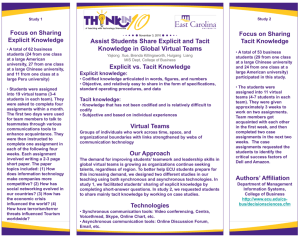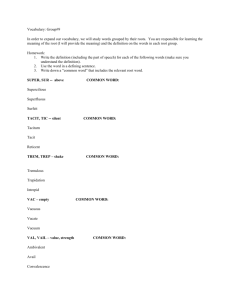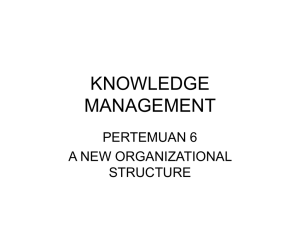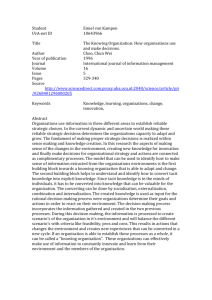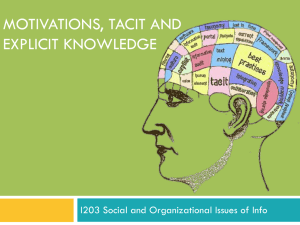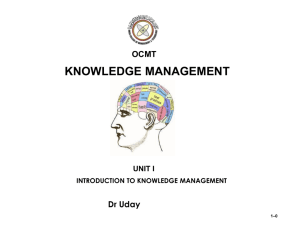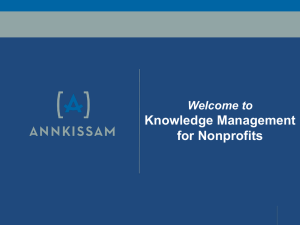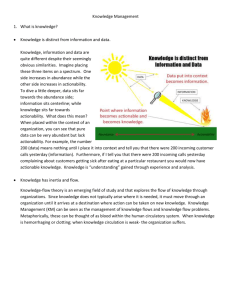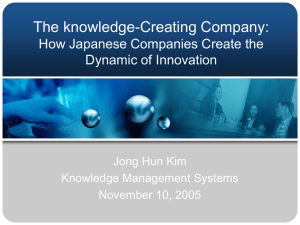Figure 5.1. Shifting From an Industry Focus to a Resource Focus
advertisement
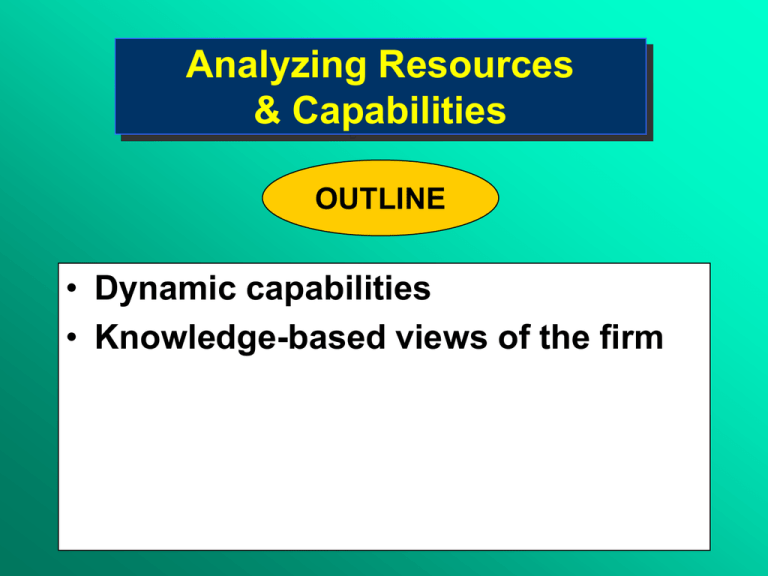
Analyzing Resources & Capabilities OUTLINE • Dynamic capabilities • Knowledge-based views of the firm Distinctive Capabilities as a Consequence of Childhood Experiences Company Capability Past History Exxon Financial management Exxon’s predecessor, Standard Oil (NJ) was the holding co. for Rockefeller’s Standard Oil Trust RD/ Shell Coordinating decentralized global empire Shell a j-v formed from Shell T&T founded to sell Russian oil in China, and Royal Dutch founded to exploit Indonesian reserves BP “Elephant hunting” Discovered huge Persian reserves, went on to find Forties Field and Prudhoe Bay ENI Deal making in politicized environments The Enrico Mattei legacy; the challenge of managing government relations in post-war Italy Mobil Lubricants Vacuum Oil Co. founded in 1866 to supply patented petroleum lubricants 2 Approaches to Capability Development 1) Acquire and develop the underlying resources. Especially human resources --Externally (hiring) --Internally through developing individual skills 2) Acquire/access capabilities externally through acquisition or alliance 3) Greenfield development of capabilities in separate organizational unit (IBM & the PC, Xerox & PARC, GM & Saturn) 4) Build team-based capabilities through training and team development (i.e. develop organizational routines) 5) Align structure & systems with required capabilities 6) Change management to transform values and behaviors (GE, BP) 7) Product sequencing (Intel , Sony, Hyundai) 8) Knowledge Management (systematic approaches to acquiring, storing, replicating, and accessing knowledge) Product Sequencing to Build Capabilities: Hyundai Capabilities •Assembly •Production engineering •Local marketing SKD CKD Ford Cortina Products 1968 •Auto styling &design •Casting & forging •Chassis design •Tooling •Body production •Export mktg. Pony 1970 •Hydrodynamics •Thermodynamics •Fuel engineering •Emission control •FWD •Lubrication engineering •Kinetics& vibration •CAD/CAM •Ceramics •Assembly •Electronic control control systems systems •Large-scale •Advanced design integration component •Global logistics handling •Lifecycle engineering Excel 1974 ‘Alpha’ engine 1985 Accent Avante Sonanta 1994-95 Summary: A Framework for Analyzing Resources and Capabilities 4. Develop strategy implications: (a) In relation to strengths--How can these be exploited more effectively and fully? (b) In relation to weaknesses --Identify opportunities to outsourcing activities that can be better performed by other organizations. --How can weaknesses be corrected through acquiring and developing resources and capabilities? 3. Appraise the firm’s resources and capabilities in terms of: (a) strategic importance (b) relative strength 2. Explore the linkages between resources and capabilities 1. Identify the firm’s resources and capabilities STRATEGY POTENTIAL FOR SUSTAINABLE COMPETITIVE ADVANTAGE CAPABILITIES RESOURCES Knowledge Management and the Knowledge-based View of the Firm OUTLINE 1) Why the surge of interest in knowledge management (KM)? --knowledge as the key resource of the firm --giving us a better understanding of management 2) What is KM? 3) What progress have we made, what are the key gaps, which areas are likely to add most value? 4) Developing strategy: Exploiting strengths, protecting and eliminating weaknesses 5) Building the capability base: Can it be done? How? 6) What can be learn from Knowledge Management? 7) Implications for organizational structure. What is Knowledge Management? Intellectual Courses & Seminars On-theCapital Data job Accounting mining Benchmarkin Training Intellectual g Property IT New Product Protection Development Customer & Best Communications Market Analysis Practice Strategic Alliances Scenario Transfer T Q M Lesson Analysis s ERP Research CRM learned Definition: “The systematic leveraging of information and expertise to improve organizational innovation, responsiveness, productivity and competency.” (Lotus division of IBM) Knowledge Processes within the Organization Knowledge Creation Knowledge Generation (“Exploration”) • Training Knowledge Acquisition Knowledge Integration Knowledge Sharing Knowledge Application (“Exploitation”) • Research Knowledge Replication Knowledge Storage & Organization • Recruitment • Intellectual property licensing • Benchmarking • New product development • Operations • Strategic planning • Communities of practice • Best practices transfer • On-the-job training • Databases • Standard operating practices Knowledge Measurement • Intellectual capital accounting • Competency modeling Knowledge Identification • Project reviews • Competency modeling Types & Levels of Knowledge (and Knowledge Conversion) Levels of knowledge Individual Explicit Information Facts Scientific kn. Organization Databases Systems & procedures Intellectual property Types of Knowledge Tacit Skills Know-how Organizational routines Replication through Knowledge Systematization Levels of knowledge Individual Explicit Types of Knowledge EXAMPLES • Ford • McDonalds • Starbucks •Accenture Tacit Information Facts Scientific kn. Organization Databases Systems & procedures Intellectual property ‘INDUSTRIAL’ ENTERPRISES CRAFT ENTERPRISES Skills Organizational capabilities Nonaka’s Knowledge Conversion Matrix Tacit Knowledge Tacit Knowledge TO SOCIALIZATION Sharing of tacit knowledge among individuals and from the organization to the individual Explicit Knowledge EXTERNALIZATION The articulation and systematization of tacit into explicit knowledge. Use of metaphor to communicate tacit concepts FROM Explicit Knowledge INTERNALIZATION Instructions and principles are converted into intuition and routines COMBINATION A key role of information systems is to combine different units of information and other forms of explicit knowledge Knowledge Transfer Mechanisms D I S S E M I N A T I O N B R E A D T H M a n y Rules, procedures & directives Modular integration Manuals & reports Communities Communities -of-interest -of-practice F e w E-mail Group -ware Internal consultants Personnel transfer Shared data bases Training seminars Video & conferencing courses Meetings On-the job training Informal visits Data exchange Fax Telephone Low (know-how & contextual kn..) ABILITY TO CODIFY High (explicit kn.. & information Designing a Knowledge Management System • What kn. processes which are critical to creating value & competitive advantage? --Dow: creating and exploiting patents --McKinsey & Co.: sharing kn. & retaining experienced consultants --Accenture: systematization.) • What are the characteristics of the relevant kn.? • What mechanisms are needed for the generation and application of the relevant kn.? • What organizational conditions need to be in place in order for knowledge management mechanisms to work? ---Organizational structures ---Incentives to contributors and users ---Behavioral norms and values Case: Eastman Kodak • What is Kodak’s strategy for developing its digital imaging business? • What progress has Kodak made? • What challenges does Kodak face and what are its prospects of becoming a leader in digital imaging? • What advice would you offer Dan Carp?

